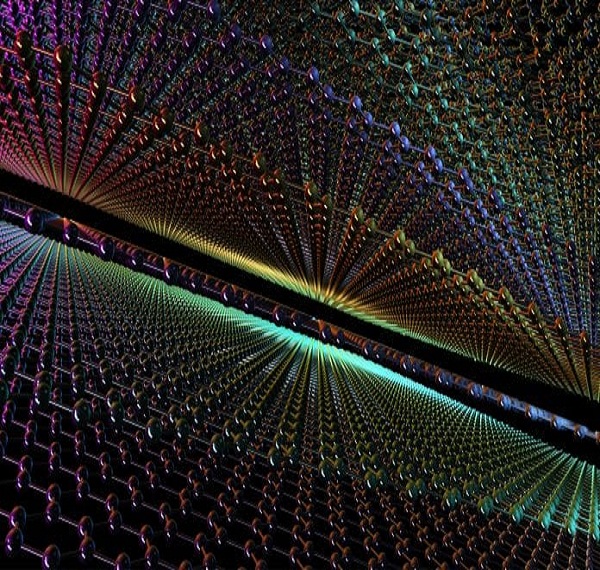Research and innovation in the burgeoning field of nanomaterials have produced a range of practical developments, with potential applications from lighting to 3D printing to medical diagnosis.
A research paper published in July 2019 details researchers’ success in producing the coveted ‘supermaterial’ graphene by mixing oxidised graphite with bacteria. The study, conducted at Delft University in the Netherlands and published in the ChemOpen journal, found that using the bacteria to deoxidise exfoliated graphite material resulted in the production of graphene in a substantially more cost effective, time efficient and sustainable process than previous graphene production endeavours. The bacterially produced material retained the conductivity of chemically produced graphene; but was thinner and less volatile.
Graphene, the thinnest known two-dimensional (2D) material at only an atom thick, has been in high demand since its discovery due to its strength, flexibility and conductivity; however, the process of graphene production is typically costly and unable to yield the amounts needed for large scale projects.
Anne S Meyer PhD, Associate Professor of Biology at the University of Rochester in New York and co-author of the study, said: “For real applications [of graphene] you need large amounts. Producing these bulk amounts is challenging and typically results in graphene that is thicker and less pure…Our bacterially produced graphene material will lead to far better suitability for product development – we were even able to develop a technique of ‘bacterial lithography’ to create graphene materials that were only conductive on one side, which can lead to the development of new, advanced nanocomposite materials.”
Nanomaterials used in LED production
Graphene and other 2D materials are being used to produce a low voltage LED which could potentially revolutionise energy efficiency in light emitting devices.
Recent studies conducted at the Universities of Manchester and Warsaw, the High Magnetic Field Laboratory in Grenoble and the National Institute for Materials Science in Japan have resulted in the development of a more efficient, lower voltage LED being developed.
By using atomically thin combined semiconductors, researchers were able to produce an LED that uses a far lower voltage. These findings could potentially lead to devices consuming far less energy. Researchers created new heterostructures, a structure previously used in semiconductors, by holding two atomically thin structures, such as graphene, by using weak Van der Waals forces.
With hundreds of combinations of these Van der Waal heterostructures could potentially hold the key to more efficient materials and devices, especially optoelectric devices.
Dr Aleksey Kozikov of Manchester University’s National Graphene Institute said: “It is fascinating how adding just one atomically thin material can change properties of a device so dramatically. This is the power of van der Waals heterostructures in action.”
The findings highlight that researchers bound electrons to the holes in different dichalcogenides in transitional metals. As a result of their research, charge carriers whose energy was originally too low to overcome the materials band gap, can now cross the potential barrier, recombine and then emit light.
2D materials for 3D printing
Researchers at the University of Manchester have created a highly conductive 3D printable ink using 2D material, MXene. Researchers at The University of Manchester have been using MXene to 3D print electrodes for use in energy storage devices such as super capacitors, a device which is able to produce huge amounts of power with minimal energy expenditure.
Created at Drexel University in Philadelphia, MXene, which is referred to by researchers as a “clay-like” material composed of early transition metals like titanium, is an uncharacteristically conductive clay once dry. Due to its being hydrophilic, it allows for easy disbursement in liquids such as inks.
The discovery of the world’s first two-dimensional material, graphene, has opened doors for the exploration of other 2D materials with varying properties which have not been seen before in materials of their kind.
Dr Suelen Barg, who led the team that created the 3D printable ink using 2D MXene, said: “We demonstrate that large MXene flakes spanning a few atoms thick, and water can be independently used to formulate inks with very specific viscoelastic behaviour for printing. These inks can be directly 3D printed into freestanding architectures over 20 layers tall. Due to the excellent electrical conductivity of MXene, we can employ our inks to directly 3D print current collector-free super capacitors. The unique properties combined with the sustainability of the approach open many opportunities to explore, especially in energy storage and applications requiring the functional properties of 2D MXene in customised 3D architectures.”
Nano-gold
Scientist at the University of Leeds have developed the thinnest unsupported gold ever created. The gold is 0.47 nanometres thick, approximately one million times thinner than a human fingernail.
With a thickness of just two atoms, the material is counted as a 2D material with wide scale potential application in the medical and electronics industries. The ultra-thin gold could also be used to speed up chemical reactions in a range of industries, as tests show that it is ten times more efficient as a catalytic substrate than the existing gold nanoparticles.
Researchers believe the new 2D material could also be utilised in the formation of artificial enzymes; in point-of-care medical diagnostic tests; and in water purification systems.
The main author of the study, Dr Sunjie Ye, said: “This work amounts to a landmark achievement […] Not only does it open up the possibility that gold can be used more efficiently in existing technologies, it is providing a route which would allow material scientists to develop other 2D metals […] This method could innovate nanomaterial manufacturing.”
In order to begin synthesising the 2D gold sheet, researchers use an aqueous solution while moving on to adding chloroauric acid which is an inorganic substance containing gold. The chloroauric acid solution is reduced to its metallic form before a “confinement agent” is added to encourage the gold to form in a sheet two atoms thick.
Source: scitecheuropa










